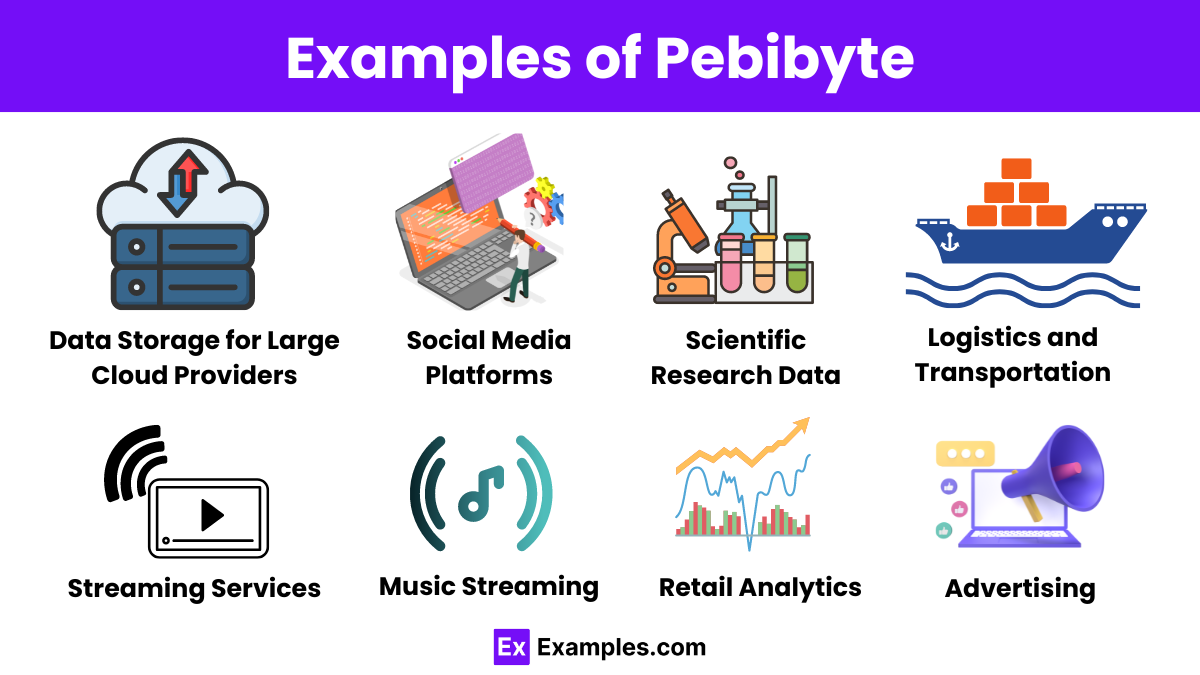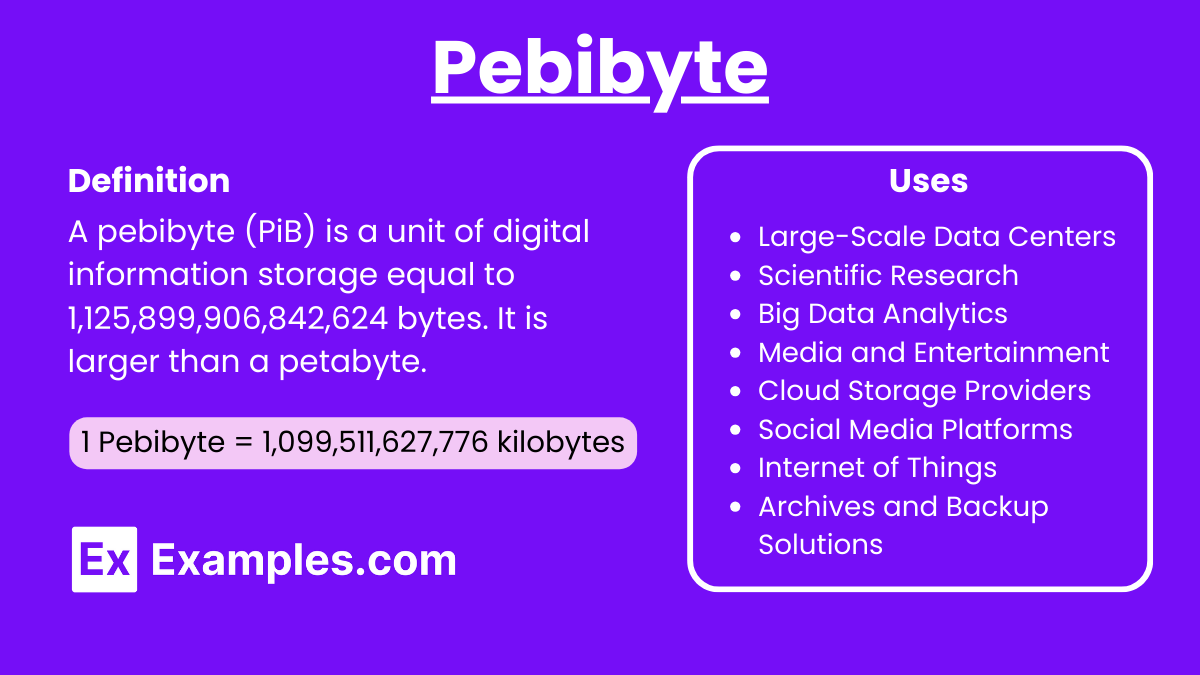Pebibyte – 30+ Examples, Uses, Units, Differences
A Pebibyte (PiB) is a unit of digital information storage that equals 2^50 bytes or approximately 1.1258999 petabytes. In the realm of cloud computing, the massive storage capabilities of pebibytes facilitate efficient management of vast datasets. This level of storage is crucial for advancements in digital communication and the growth of communication technology, enabling seamless data exchange and storage scalability. As technology evolves, the demand for larger storage units like the pebibyte continues to increase, supporting the ever-growing digital landscape.
What is Pebibyte?
A Pebibyte (PiB) is a unit of digital information storage equal to 2^50 bytes or 1,024 tebibytes. It is approximately 1.1258999 petabytes and is used for measuring large data capacities.
Examples of Pebibyte

- Data Storage for Large Cloud Providers: Companies like Amazon Web Services and Google Cloud manage data centers that store pebibytes of information.
- Social Media Platforms: Platforms like Facebook and Twitter handle pebibytes of user-generated content, including photos, videos, and posts.
- Streaming Services: Netflix and YouTube manage pebibytes of video content in their libraries.
- Scientific Research Data: Large-scale research projects like the Human Genome Project or CERN’s Large Hadron Collider generate pebibytes of data.
- Government Databases: National archives and government databases, such as the Library of Congress, store pebibytes of records.
- Satellite Imagery: Companies like NASA and Google Earth store pebibytes of high-resolution satellite imagery.
- Healthcare Records: Large hospital networks and research institutions store pebibytes of patient records and medical images.
- Financial Transactions: Banks and financial institutions handle pebibytes of transaction data and market information.
- E-commerce Data: Online retailers like Amazon store pebibytes of customer data, product information, and transaction records.
- Telecommunications: Telecom companies manage pebibytes of call records, messages, and internet usage data.
- IoT Devices: The Internet of Things generates pebibytes of data from millions of connected devices.
- Gaming: Online gaming platforms and services like Steam and Xbox Live manage pebibytes of game data and user activity.
- Educational Institutions: Universities and research institutions store pebibytes of academic research, student records, and course materials.
- Weather Forecasting: Meteorological organizations like NOAA and the Met Office store pebibytes of weather data and models.
- Business Analytics: Large corporations use pebibytes of data for business intelligence and analytics.
- Smart Cities: Urban infrastructure generates pebibytes of data from sensors and monitoring systems.
- Virtual Reality: VR platforms and content creators store pebibytes of immersive content.
- Artificial Intelligence: AI research and applications require pebibytes of data for training and operation.
- Cybersecurity: Organizations store pebibytes of logs and monitoring data for cybersecurity analysis.
- Digital Archives: Museums and historical organizations digitize and store pebibytes of artifacts and documents.
- Advertising: Digital advertising companies manage pebibytes of ad performance data and user behavior.
- Logistics and Transportation: Companies like UPS and FedEx manage pebibytes of tracking and delivery information.
- Space Exploration: Agencies like NASA store pebibytes of data from space missions and telescopes.
- Music Streaming: Services like Spotify and Apple Music manage pebibytes of a content.
- Image and Video Sharing: Platforms like Instagram and TikTok handle pebibytes of user-uploaded media.
- Document Management: Cloud-based document storage services manage pebibytes of documents and files.
- Energy Sector: Power companies store pebibytes of data from smart grids and energy consumption monitoring.
- Retail Analytics: Retail chains store pebibytes of sales and customer data for analysis.
- Military and Defense: Defense organizations manage pebibytes of surveillance and operational data.
- Automated Vehicles: Autonomous cars generate pebibytes of data from sensors and navigation systems.
Uses of Pebibytes
1. Large-Scale Data Centers
Data centers that handle massive amounts of information, such as those operated by tech giants like Google, Amazon, and Microsoft, often measure their storage capacities in pebibytes. These data centers store everything from user data to backups and large-scale databases.
2. Scientific Research
Scientific research fields such as genomics, astronomy, and climate science generate enormous datasets. For example:
- Genomics: Sequencing and analyzing DNA involves vast amounts of data, often measured in pebibytes.
- Astronomy: Telescopes and space missions collect data from the universe, resulting in pebibytes of information.
- Climate Science: Climate models and simulations require storing and processing huge datasets.
3. Big Data Analytics
Companies involved in big data analytics, such as those in finance, marketing, and healthcare, use pebibytes to manage and analyze large volumes of data. This helps them extract valuable insights and make data-driven decisions.
4. Media and Entertainment
The media and entertainment industry, particularly those dealing with high-definition video, a, and image files, frequently deal with pebibytes of data. For example:
- Streaming Services: Companies like Netflix and YouTube manage huge libraries of video content.
- Film Production: High-resolution film production and editing generate large data files that require significant storage.
5. Cloud Storage Providers
Cloud storage services, such as Google Drive, Dropbox, and iCloud, use pebibytes to offer scalable storage solutions to millions of users. These providers need vast storage capacities to manage user data and ensure quick access and backups.
6. Social Media Platforms
Social media giants like Facebook, Twitter, and Instagram store massive amounts of user-generated content, including photos, videos, and messages. This content is often measured in pebibytes.
7. Internet of Things (IoT)
With the rise of IoT, devices continuously generate data that needs to be stored and processed. This data, collected from smart homes, cities, and industries, can accumulate to pebibytes over time.
8. Archives and Backup Solutions
Organizations and governments archive and back up critical data, often reaching pebibyte scales. This ensures data preservation and recovery in case of system failures or disasters.
How large is a pebibyte?
A pebibyte (PiB) is a unit of digital information storage used to quantify large amounts of data. To understand how large a pebibyte is, let’s break it down in relation to other data units:
1 pebibyte = 2^50 bytes 1 pebibyte = 1,125,899,906,842,624 bytes
Here are some comparisons to give a clearer picture of its size:
Comparison with Smaller Units
- 1 byte: A single character of text.
- 1 kilobyte (KB): 1,024 bytes, approximately one paragraph of text.
- 1 megabyte (MB): 1,024 kilobytes, roughly one minute of MP3 a.
- 1 gigabyte (GB): 1,024 megabytes, about one hour of standard-definition video.
- 1 terabyte (TB): 1,024 gigabytes, roughly 250,000 high-resolution photos.
Comparison with Larger Units
- 1 exabyte (EB): 1,024 pebibytes, used to measure data on an internet-wide scale.
Real-World Analogies
To better understand the magnitude of a pebibyte, consider these real-world analogies:
- Digital Library: A pebibyte could store around 223,000 DVDs worth of data.
- Streaming Video: It can hold approximately 13.3 years of HD video (assuming 2.5 GB per hour).
- Digital Photos: One pebibyte could store around 350 million high-resolution photos (assuming 3 MB per photo).
Units of Pebibyte
A pebibyte (PiB) is a unit of digital information storage that follows the binary system (base-2). It is larger than most common data units and is specifically used to measure substantial amounts of data. Here is a breakdown of the units of a pebibyte:
1 pebibyte = 1,125,899,906,842,624 bytes
Comparison with Other Units
| Unit | Symbol | Bytes | Relation to Pebibyte |
|---|---|---|---|
| Byte | B | 1 | 1 PiB = 1,125,899,906,842,624 B |
| Kilobyte | KB | 1,000 bytes | 1 PiB = 1,125,899,906,842.6 KB |
| Kibibyte | KiB | 1,024 bytes | 1 PiB = 1,099,511,627,776 KiB |
| Megabyte | MB | 1,000,000 bytes | 1 PiB = 1,125,899,906.8 MB |
| Mebibyte | MiB | 1,048,576 bytes | 1 PiB = 1,073,741,824 MiB |
| Gigabyte | GB | 1,000,000,000 bytes | 1 PiB = 1,125,899.9 GB |
| Gibibyte | GiB | 1,073,741,824 bytes | 1 PiB = 1,048,576 GiB |
| Terabyte | TB | 1,000,000,000,000 bytes | 1 PiB = 1,125.9 TB |
| Tebibyte | TiB | 1,099,511,627,776 bytes | 1 PiB = 1,024 TiB |
| Petabyte | PB | 1,000,000,000,000,000 bytes | 1 PiB ≈ 1.13 PB |
| Pebibyte | PiB | 1,125,899,906,842,624 bytes | 1 PiB = 1 PiB |
| Exabyte | EB | 1,000,000,000,000,000,000 bytes | 1 PiB = 0.00113 EB |
| Exbibyte | EiB | 1,152,921,504,606,846,976 bytes | 1 PiB = 0.000976 EiB |
Binary vs. Decimal Units
- Binary Units: Units like kibibyte (KiB), mebibyte (MiB), gibibyte (GiB), tebibyte (TiB), and pebibyte (PiB) follow the base-2 (binary) system, where each unit is a power of 2.
- Decimal Units: Units like kilobyte (KB), megabyte (MB), gigabyte (GB), terabyte (TB), and petabyte (PB) follow the base-10 (decimal) system, where each unit is a power of 10.
Pebibyte vs. Petabyte and Tebibyte
| Unit | Symbol | Bytes | Equivalent in Other Units |
|---|---|---|---|
| Pebibyte | PiB | 1,125,899,906,842,624 bytes | 1,024 TiB (Tebibytes), 1,048,576 GiB (Gibibytes) |
| Petabyte | PB | 1,000,000,000,000,000 bytes | 1,000 TB (Terabytes), 1,000,000 GB (Gigabytes) |
| Tebibyte | TiB | 1,099,511,627,776 bytes | 1,024 GiB (Gibibytes), 1,048,576 MiB (Mebibytes) |
How many bytes are in a pebibyte?
A pebibyte contains 1,125,899,906,842,624 bytes, making it ideal for PaaS storage solutions.
What’s the difference between a pebibyte and a petabyte?
A pebibyte (PiB) is larger, using a binary system, unlike a petabyte (PB), used in PaaS.
Why are pebibytes used in computing?
Pebibytes offer precise binary measurements, crucial for large-scale data in PaaS and electromagnetism research.
How does PaaS benefit from pebibytes?
PaaS platforms leverage pebibytes for vast data storage, ensuring scalability and efficiency.
Is pebibyte storage relevant to electromagnetism studies?
Yes, electromagnetism research generates massive data sets, often stored in pebibytes for analysis.
How many terabytes are in a pebibyte?
One pebibyte equals 1,024 terabytes, crucial for PaaS storage capacity.
Can PaaS handle pebibyte-scale storage?
Yes, PaaS platforms are designed to manage pebibyte-scale storage, ensuring robust data handling.
What fields benefit from pebibyte storage?
Fields like PaaS and electromagnetism heavily rely on pebibyte storage for managing extensive data.
How are pebibytes used in scientific research?
Pebibytes store large datasets from fields like electromagnetism, crucial for in-depth analysis.
How do pebibytes impact data storage in PaaS?
Pebibytes offer substantial storage capacity, vital for PaaS platforms handling extensive user data.


